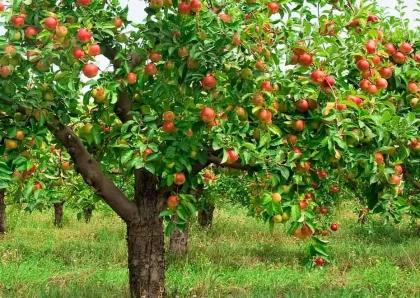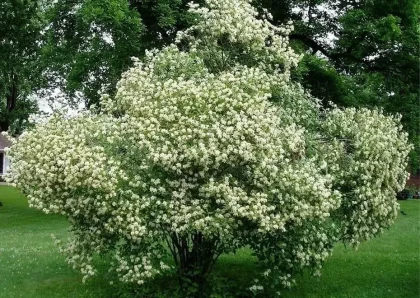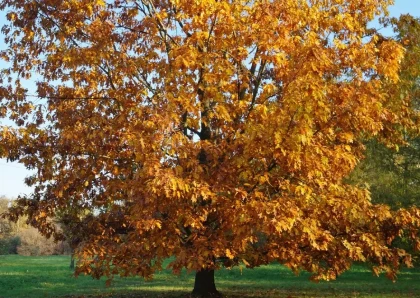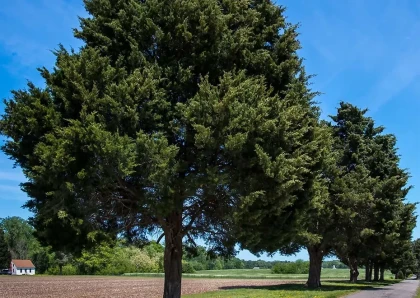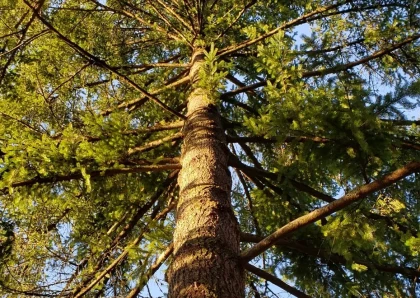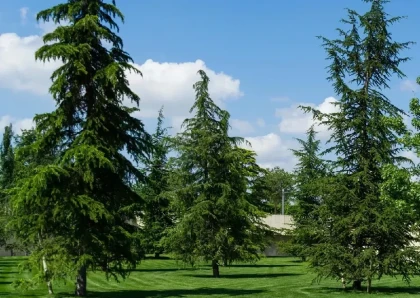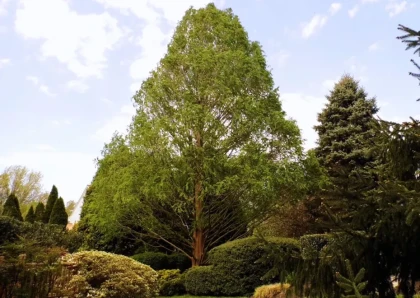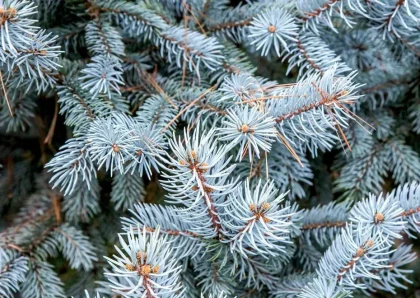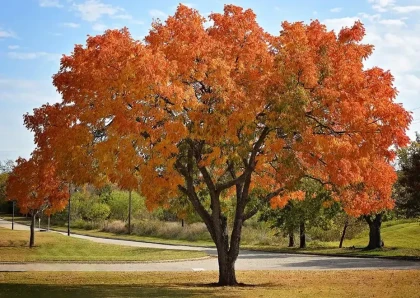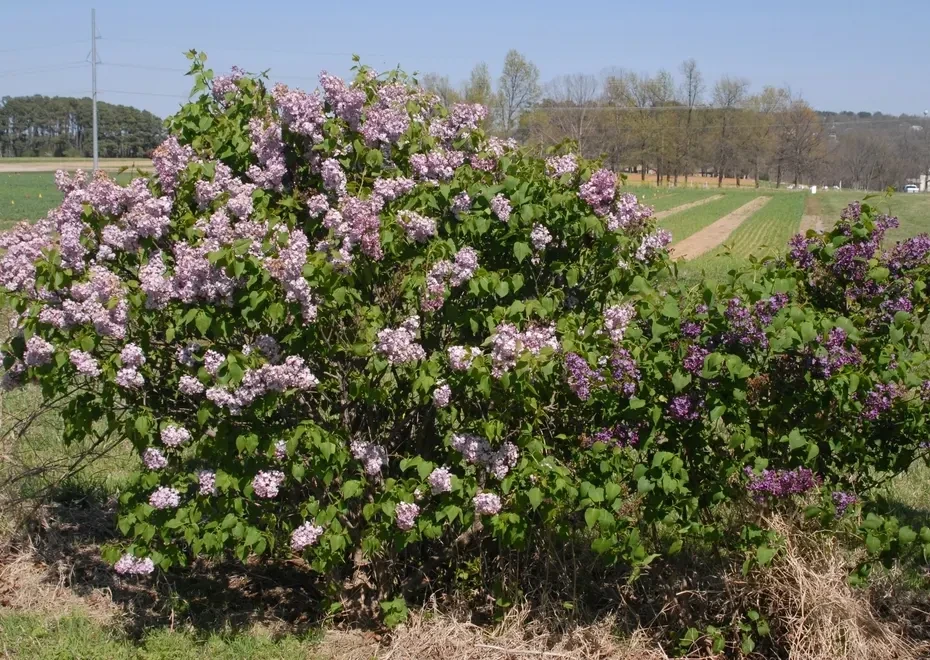
Common Fragrant Lilac
Overview
Syringa vulgaris, commonly known as the Common Lilac or French Lilac, is a deciduous shrub belonging to the genus Syringa in the olive family (Oleaceae). It is one of the most popular and widely cultivated species of lilacs, prized for its stunning and fragrant flowers.
Here are some key features of Syringa vulgaris- Appearance: The Common Lilac typically grows to a height of 8 to 15 feet (2.4 to 4.5 meters) with a spread of 6 to 12 feet (1.8 to 3.6 meters). It has a dense, upright or rounded growth habit with multiple stems arising from the base. The leaves are heart-shaped, opposite, and medium to dark green in color.
- Flowers: The main attraction of Syringa vulgaris is its sweetly scented flowers. The blossoms are tubular and appear in large, pyramidal clusters called panicles at the tips of the branches. The flower colors can vary and include shades of purple, lavender, pink, white, and even some bicolor varieties.
- Bloom Time: Lilac flowers typically bloom in the late spring, depending on the climate and local growing conditions. The flowering period usually lasts for a few weeks, adding a delightful touch of color and fragrance to gardens during this time.
- Fragrance: The flowers of Syringa vulgaris emit a strong, pleasant fragrance that is one of the hallmarks of this plant. The scent is often described as sweet, floral, and slightly spicy.
- Hardy and Easy to Grow: Lilacs are generally hardy and easy to grow, making them a popular choice for gardeners in temperate regions. They prefer well-draining soil and full sun exposure for optimal growth and flowering.
- Cultural Significance: Lilacs have a long history of cultural significance, particularly in Europe and North America. They are associated with spring, renewal, and the end of winter, and are commonly used in various cultural and religious traditions.
Different Cultivars of Common Fragrant Lilac (Syringa vulgaris)
- Common Purple Lilac: The original and most well-known form of Syringa vulgaris with deep purple flowers.
- White Lilac: Features pure white flowers that are highly fragrant.
- Pink Lilac: Exhibits soft pink flowers, ranging from light pink to deeper shades.
- Lavender Lilac: Displays lovely lavender-colored flowers.
- Blue Lilac: Has flowers that appear bluish in color.
- Bicolor Lilacs: These cultivars have flowers with more than one color, such as white with a hint of pink or vice versa.
- 'Charles Joly': A popular cultivar with double, deep purplish-red flowers and a strong fragrance.
- 'Mme. Lemoine': A double white lilac with a pleasant fragrance.
- 'President Grevy': Known for its large double flowers, purplish-blue in color.
- 'Sensation': A bicolor lilac with dark purple flowers edged in white.
- 'Primrose': A rare cultivar with creamy yellow flowers.
- 'Krasavitsa Moskvy' (Beauty of Moscow): A cultivar with double, pinkish-white flowers and a sweet fragrance.
- 'Monge': Features single, magenta-red flowers with a strong fragrance.
- 'Andenken an Ludwig Spaeth': A dark purple cultivar with a powerful fragrance.
Different Types of Product that can be made from Common Fragrant Lilac (Syringa vulgaris)
- Perfumes and Fragrances: The flowers of Syringa vulgaris are highly fragrant and are used in the production of perfumes, colognes, and other fragrances.
- Essential Oils: The essential oil extracted from lilac flowers is valued for its sweet and floral aroma. It is used in aromatherapy and as an ingredient in various cosmetic and personal care products.
- Potpourri: Dried lilac flowers can be used in potpourri mixes to add a pleasant and natural fragrance to rooms and closets.
- Floral Arrangements: Fresh lilac flowers are commonly used in floral arrangements and bouquets due to their beauty and fragrance.
- Herbal Remedies: In some traditional medicinal practices, parts of Syringa vulgaris, such as the leaves and flowers, are used for their purported medicinal properties.
- Culinary Uses: In certain cultures, lilac flowers can be used to infuse syrups, sugars, or teas to add a delicate floral flavor to culinary creations.
- Cosmetics: Lilac extracts or fragrance may be used in various cosmetic products, such as soaps, lotions, and creams, to impart a pleasant scent.
- Natural Dyes: Lilac flowers have been used to create natural dyes for textiles and crafts.
- Potentially, in Herbal Teas: Some people may use dried lilac flowers or leaves to make herbal teas, although it's essential to be cautious about consuming any plant material and to ensure it is safe and suitable for consumption.
Benefits of Common Fragrant Lilac
- Aesthetic Appeal: Syringa vulgaris is widely admired for its stunning and fragrant flowers. The flowers come in a range of colors, including shades of purple, pink, white, and blue, adding beauty and charm to gardens and landscapes.
- Fragrance: One of the most significant benefits of Syringa vulgaris is its delightful and sweet fragrance. The flowers emit a strong and pleasant scent, which enhances the outdoor environment and provides a sensory delight.
- Landscaping: Lilacs are popular choices for landscaping due to their attractive appearance and pleasant fragrance. They can be used as focal points, hedges, or borders in garden designs.
- Pollinator Attraction: The fragrant flowers of Syringa vulgaris attract pollinators like bees and butterflies. They play a crucial role in supporting biodiversity and promoting a healthy ecosystem.
- Cut Flowers: Lilac flowers make lovely cut flowers for indoor arrangements. Their fragrance can fill a room, bringing the beauty of the garden indoors.
- Cultural Significance: Syringa vulgaris has a rich history of cultural significance, especially in Europe and North America. It is associated with spring, renewal, and the end of winter, making it a symbol of hope and new beginnings.
- Herbal and Traditional Uses: Some traditional medicinal practices use parts of Syringa vulgaris, such as the leaves and flowers, for herbal remedies. However, it's essential to consult with experts and be cautious about using any plant material for medicinal purposes.
- Low Maintenance: Lilacs are generally low-maintenance shrubs, making them suitable choices for gardeners with varying levels of experience.
- Privacy and Wind Barrier: When planted as hedges, lilacs can act as privacy screens and windbreaks, providing a sense of seclusion and protection.
- Tolerant of Cold Climates: Syringa vulgaris is hardy and can tolerate cold climates, making it a viable option for gardens in temperate and colder regions.
Tips for planting and maintaining Common Fragrant Lilac
- Choosing the Right Location: Lilacs prefer full sun, so select a spot in your garden that receives at least 6 to 8 hours of direct sunlight daily. Ensure good air circulation around the plant to prevent diseases.
- Soil Preparation: Lilacs thrive in well-draining soil that is slightly alkaline to neutral (pH 6.5 to 7.5). Work in organic matter like compost to improve soil fertility and drainage.
- Planting: Plant your lilac in the spring or fall when the weather is mild. Dig a hole that is about twice as wide as the root ball and deep enough to accommodate the roots. Place the lilac in the hole, ensuring that the top of the root ball is level with the soil surface. Backfill the hole with soil, and water thoroughly.
- Watering: Keep the soil evenly moist, especially during the first year after planting. Once established, lilacs are relatively drought-tolerant, but they still benefit from regular watering during dry spells.
- Mulching: Apply a 2-3 inch layer of organic mulch, such as wood chips or straw, around the base of the lilac to retain soil moisture and suppress weeds. Avoid piling mulch against the trunk to prevent moisture-related issues.
- Pruning: Prune lilacs right after they finish blooming, usually in late spring or early summer. This ensures you don't remove next year's flower buds. Remove dead, diseased, or damaged branches and cut back old wood to promote new growth and rejuvenate the plant. Trim the lilac to shape it and control its size if needed.
- Fertilizing: Lilacs generally don't require heavy fertilization. In most cases, the nutrients provided by organic mulch and compost are sufficient. If your lilac is not blooming well or showing signs of nutrient deficiency, you can apply a balanced fertilizer in early spring.
- Pest and Disease Management: Lilacs are relatively resistant to pests and diseases. However, you should keep an eye out for common issues like powdery mildew or aphids. Regularly inspect your plant and take appropriate action if you notice any problems.
- Propagation: Lilacs can be propagated through softwood cuttings taken in late spring or early summer. You can also try propagating them from seeds, but it may take longer to see blooms.
Cons of planting Common Fragrant Lilac
- Large Size: Common Fragrant Lilac can grow into a relatively large shrub, reaching up to 8 to 15 feet in height and spread. This size may not be suitable for small gardens or limited spaces.
- Spreading Habit: Lilacs have a tendency to spread through suckers, which are shoots that emerge from the base of the main plant. This can lead to the lilac forming dense thickets and potentially invading nearby areas.
- Limited Blooming Period: While lilacs are admired for their beautiful and fragrant flowers, the blooming period is relatively short, typically lasting for a few weeks in late spring to early summer. After the blooming period, the plant's attractiveness diminishes until the next flowering season.
- Pruning Requirements: Lilacs require regular pruning to maintain their shape, promote new growth, and encourage abundant flowering. Improper pruning or neglecting to prune can lead to a messy and unattractive appearance.
- Specific Soil and Sunlight Requirements: Lilacs prefer well-draining soil that is slightly alkaline to neutral. If your soil is too acidic, it may be challenging to grow lilacs without significant soil amendments. Additionally, they thrive in full sun and may not perform well in heavily shaded areas.
- Potential Pests and Diseases: While lilacs are generally hardy plants, they can still be susceptible to certain pests and diseases. Common issues include aphids, powdery mildew, leaf spot, and borers, which can affect the plant's health and appearance.
- Non-Native Plant: In some regions, Common Fragrant Lilac may be considered invasive if it escapes cultivation and spreads into natural areas, potentially outcompeting native plants.
- Short Blooming Season: The lilac's short flowering period can be disappointing for gardeners who desire plants with longer-lasting blooms.
- Allergies: Some individuals may be allergic to lilac pollen or the strong fragrance, leading to allergic reactions such as sneezing, runny nose, or itchy eyes.
- Messy Blooms: After the lilac blooms, spent flowers can drop and create a mess on the ground, requiring cleanup.
Conclusion
In conclusion, Common Fragrant Lilac (Syringa vulgaris) is a captivating and aromatic shrub that offers numerous benefits to gardens and landscapes. Its stunning flowers, delightful fragrance, and rich cultural history make it a popular choice among gardeners. However, there are some considerations to keep in mind before planting this shrub.
On the positive side, the lilac's aesthetic appeal and fragrance add charm and beauty to outdoor spaces, making it an excellent choice for creating focal points or hedges in garden designs. Its flowers attract pollinators, supporting biodiversity and contributing to a healthy ecosystem. Moreover, lilac flowers can be used as lovely cut flowers, bringing the scents and beauty of the garden indoors.
Despite these advantages, there are some potential drawbacks to consider. The lilac's large size may not be suitable for small gardens, and its spreading habit can lead to the formation of dense thickets if not managed properly. Additionally, the blooming period is relatively short, and proper pruning is essential to maintain the plant's appearance and promote healthy growth.
Furthermore, lilacs have specific soil and sunlight requirements, and they can be susceptible to pests and diseases, though they are generally hardy. In some regions, they may be considered invasive if they escape cultivation.
Overall, if you have the space and are willing to provide proper care and maintenance, Common Fragrant Lilac can be a valuable addition to your garden, offering an enchanting sensory experience with its alluring flowers and fragrance. Its historical and cultural significance, coupled with its ability to withstand cold climates, make it a beloved choice for gardens in temperate and colder regions. By weighing the pros and cons and considering your specific gardening needs, you can make an informed decision about whether to plant Common Fragrant Lilac and enjoy its beauty and aroma for years to come.
FAQs
-
1. What is Common Fragrant Lilac?
Common Fragrant Lilac, also known as Syringa vulgaris, is a deciduous shrub renowned for its stunning and fragrant flowers. It belongs to the Oleaceae family and is native to Southeastern Europe. -
2. When does Common Fragrant Lilac bloom?
Common Fragrant Lilac typically blooms in late spring to early summer. The exact timing of flowering may vary depending on the climate and growing conditions. -
3. How tall does Common Fragrant Lilac grow?
Common Fragrant Lilac can reach a height of 8 to 15 feet and has a spread of about 6 to 12 feet. It's essential to consider its size when planning its placement in your garden. -
4. What colors do the flowers of Common Fragrant Lilac come in?
The flowers of Common Fragrant Lilac come in a variety of colors, including shades of purple, pink, white, and blue. Some cultivars may have bi-colored or multi-colored flowers as well. -
5. How do I care for Common Fragrant Lilac?
Common Fragrant Lilac thrives in well-draining soil with full sun exposure. It's generally low-maintenance but benefits from regular watering, especially during the first year after planting. Pruning after flowering and providing occasional fertilization can also promote healthy growth and abundant blooms. -
6. Can Common Fragrant Lilac be grown in containers?
While Common Fragrant Lilac is typically grown as a large shrub in the ground, some dwarf or compact varieties can be suitable for container gardening. Ensure the container has good drainage and provides enough space for the lilac's roots to grow. -
7. Does Common Fragrant Lilac attract pollinators?
Yes, the fragrant flowers of Common Fragrant Lilac attract pollinators such as bees and butterflies. These pollinators play a vital role in the plant's reproductive process and support biodiversity in the surrounding environment. -
8. Is Common Fragrant Lilac deer-resistant?
Common Fragrant Lilac is known to be relatively deer-resistant, meaning that deer are less likely to browse on its foliage. However, deer preferences can vary by region and environmental conditions. -
9. Can Common Fragrant Lilac tolerate cold climates?
Yes, Common Fragrant Lilac is hardy and can tolerate cold climates. It is well-suited for gardens in temperate and colder regions. -
10. What are some popular cultivars of Common Fragrant Lilac?
Some popular cultivars of Common Fragrant Lilac include 'Charles Joly' (deep reddish-purple flowers), 'Katherine Havemeyer' (pink flowers), 'Mme. Lemoine' (double white flowers), and 'President Grevy' (blue flowers), among others.
No listings available
Related Products
Golden Jubilee Peach Tree
Prunus persica 'Golden Jubilee' is a specific cultivar of peach tree. It is a deciduous fruit tree belonging to the Rosaceae family. 'Golden Jubilee'...
Gray Dogwood
Cornus racemosa, commonly known as the gray dogwood or northern swamp dogwood, is a deciduous shrub native to eastern North America. It belongs to...
European Beech Tree
The European Beech (Fagus sylvatica) is a deciduous tree species native to much of Europe, including parts of western Asia. It is one of...
Emerald Arborvitae Tree
The Emerald Arborvitae (Thuja occidentalis 'Smaragd') is a popular evergreen tree or shrub in landscaping and gardening. It belongs to the cypress family (Cupressaceae)...
Eastern Red Cedar Tree
The Eastern Red Cedar, scientifically known as Juniperus virginiana, is a species of evergreen tree native to eastern North America. It belongs to the...
Douglas Fir Tree
The Douglas Fir (Pseudotsuga menziesii) is an evergreen coniferous tree that belongs to the Pinaceae family. It is one of the most common and...
Deodar Cedar Tree
The name "Deodar" is derived from the Sanskrit words "deva" (meaning "god") and "daru" (meaning "wood" or "tree"), hence it is often referred to...
Dawn Redwood Tree
The Dawn Redwood tree, scientifically known as Metasequoia glyptostroboides, is a deciduous coniferous tree that belongs to the family Cupressaceae. It is a unique...
Colorado Blue Spruce Tree
The Colorado Blue Spruce, scientifically known as Picea pungens, is a species of coniferous tree belonging to the Pinaceae family. It is native to...
Chinese Pistache Tree
Description Overview The Chinese Pistache Tree, also known as Pistacia chinensis, is a deciduous tree that is native to China and Taiwan. It belongs...




